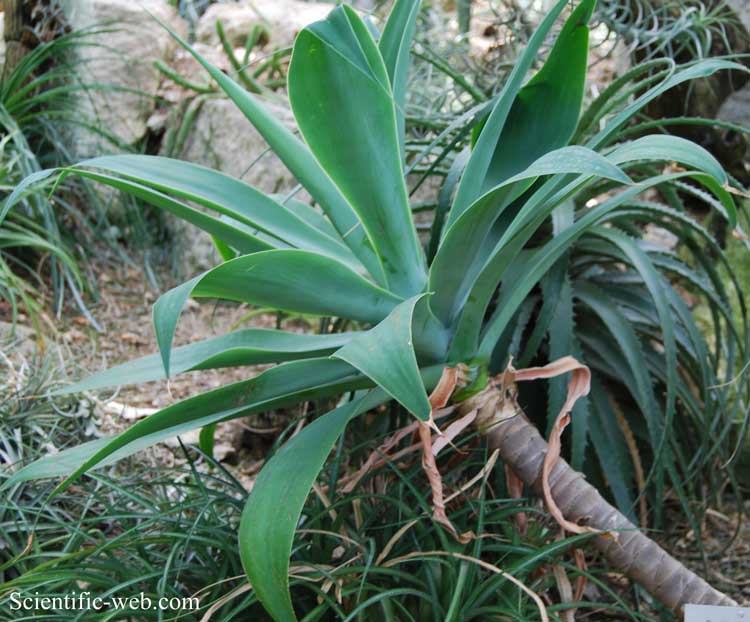
Agave attenuata, Photo: Michael Lahanas
Classification System: APG IV
Superregnum: Eukaryota
Regnum: Plantae
Cladus: Angiosperms
Cladus: Monocots
Ordo: Asparagales
Familia: Asparagaceae
Subfamilia: Agavoideae
Genus: Agave
Subgenus: A. subg. Littaea
Sectio: A. sect. Nizandensae
Species: Agave attenuata
Subspecies: A. a. subsp. attenuata – A. a. subsp. dentata
Name
Agave attenuata Salm-Dyck, 1834
Distribution
Native distribution areas:
Continental: Northern America
Regional: Mexico
Mexico Central; Mexico Northwest; Mexico Southwest
References: Brummitt, R.K. 2001. TDWG – World Geographical Scheme for Recording Plant Distributions, 2nd Edition
References
Salm-Reifferscheidt-Dyck, J. zu, 1834. Hortus Dyckensis 7:303. 1834
USDA, ARS, National Genetic Resources Program. Germplasm Resources Information Network - (GRIN) [Online Database]. [1]
Vernacular names
Deutsch: Drachenbaum-Agave
English: Fox tail agave, Foxtail agave, Smooth century plant, Spineless agave, Dragon-tree agave, Swan's neck, Lion's tail
suomi: Tähkäagaave
Agave attenuata is a species of flowering plant in the family Asparagaceae, commonly known as the foxtail or lion's tail. The name swan's neck agave refers to its development of a curved inflorescence, unusual among agaves.[3] Native to the plateaux of central west Mexico, as one of the unarmed agaves, it is popular as an ornamental plant in gardens in many other places with subtropical and warm climates.[4]
Description
Although the plant can appear acaulescent, stems often reach 50 to 150 cm (20–60 in) in length, and old leaves fall off, leaving the stems visible. The leaves are ovate-acuminate, 50–70 cm (20–28 in) long and 12–16 cm (5–6 in) wide, pale in color, ranging from a light gray to a light yellowish green. There are no teeth, nor terminal spines, although the leaves taper to soft points that fray with age. The numerous, broad, succulent, tapering leaves are slightly less rigid than most Agave species' leave;, they are a bright glaucous gray to light yellowish-green and stingless.[5]
The inflorescence is a dense raceme 2.5 to 3 meters (8 to 10 ft) high (usually curved), with greenish-yellow flowers, growing after many years.[6] As with other Agave species, the plant dies following seed development, but numerous suckers consequently sprout, both from the base of the plant and from the flower raceme.
It has two subspecies:
A. attenuata subsp. attenuata: Native to Central and Southwest Mexico and naturalized in Madeira and Libya.[7]
A. attenuata subsp. dentata (J.Verschaff.) B.Ullrich: Native to Northwest and Southwest Mexico.[8]
Etymology
The Latin specific epithet attenuata means "with a narrow point".[9]
Range
Specimens were sent to Kew Gardens by the explorer Galeotti in 1834, from an unspecified location in central Mexico. A more recent study has reported it from Jalisco, east to Mexico State, in small colonies at elevations of 1,900 to 2,500 meters (6,200 to 8,200 ft), but there have been few sightings, suggesting this agave is rare in the wild.[6] IUCN reports the species from the states of Colima, Durango, Guerrero, Jalisco, Michoacán, Nayarit and Mexico State, at altitudes between 400 and 2,500 meters (1,300 and 8,200 ft) on volcanic rock cliffs within pine forests and transitional zones of tropical dry and temperate forests types in mountains.[1] It is reportedly naturalized in Libya[10][11] and Madeira[11] and is widely spread through the Mediterranean and the rest of Macaronesia.
Cultivation
Dry seed capsules and seeds - MHNT
In cultivation, Agave attenuata is said to prefer relatively moist loamy soil, although it can cope with poor soil and dry conditions. It should be protected from direct sunlight in summer and from long periods of frost.[12] It is hardy down to USDA Zone 9b.[13][14]
Gallery
A specimen leaning as the floral stem grows
Flower raceme
Flower closeup
Fruits developing following bloom
A cluster of A. attenuata starting to form their flower spikes (overhead view)
References
García-Mendoza, A.J.; Sandoval-Gutiérrez, D.; Torres-García, I.; Linares, J. (2019). "Agave attenuata". IUCN Red List of Threatened Species. 2019: e.T114936958A114963376. doi:10.2305/IUCN.UK.2019-3.RLTS.T114936958A114963376.en. Retrieved 20 November 2021.
The Plant List, Agave attenuata
Robert Zander : Zander hand dictionary of plant names. Edited by Fritz Encke , Günther Buchheim, Siegmund Seybold .15th edition, corrected reprint of the 14th edition. Eugen Ulmer, Stuttgart 1994, ISBN 3-8001-5072-7
"Agave attenuata".
Joachim Thiede: Agave chamelensis . In: Urs Eggli (ed.): Succulent lexicon. Monocotyledons (monocotyledons) . Eugen Ulmer, Stuttgart 2001, ISBN 3-8001-3662-7 , P. 14-15 .
Howard Scott Gentry, Agaves of Continental North America (University of Arizona Press, 1982) pp. 66-71
"Agave attenuata subsp. attenuata". Catalogue of Life. Retrieved 18 January 2021.
"Agave attenuata subsp. dentata (J.Verschaff.) B.Ullrich". Catalogue of Life. Retrieved 18 January 2021.
Harrison, Lorraine (2012). RHS Latin for Gardeners. United Kingdom: Mitchell Beazley. ISBN 184533731X.
Gordon Cheers (ed.): Botanica . Random House Australia 2003. German edition: Tandem Verlag GmbH 2003, ISBN 3-8331-1600-5
"Agave attenuata Salm-Dyck". Catalogue of Life. Retrieved 18 January 2021.
Agave attenuata, The Lovely Plants
"Agave Species, Durango Soft Agave, Century Plant, Maguey". davesgarden.com. Retrieved 18 January 2021.
"Agave attenuata (Fox Tail Agave)". worldofsucculents.com. 29 April 2020. Retrieved 18 January 2021.
Retrieved from "http://en.wikipedia.org/"
All text is available under the terms of the GNU Free Documentation License

